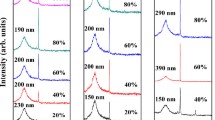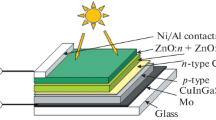Abstract
A comparative study of the effects of methane and hydrogen as reactive agents on the structural, optical, and electrical properties of ZnO thin films deposited by magnetron sputtering has been performed. The research was aimed at the identification of the nature of the previously reported strong n-type doping effect of methane. To that end, the impact of carbon and hydrogen released by the plasma decomposition of methane on the properties of ZnO films was compared with the impact of molecular hydrogen intentionally added to argon. Both methane and hydrogen caused strong enhancement of n-type conductivity in ZnO films; however, the doping effect of methane was found to be about one order of magnitude larger. The main structural effect of methane was the loss of preferential orientation and a decrease in the size of ZnO crystallites. Room-temperature photoluminescence of these films exhibited a strongly reduced green-yellow emission band in the visible spectral range accompanied by the development of a specific blue emission band. The hydrogen concentration in the ZnO films deposited using methane examined by secondary ion mass spectroscopy was found to be significantly larger than that in the films deposited using pure molecular hydrogen, which is suggested to be one of the reasons for the superior n-type doping efficiency of methane in comparison with molecular hydrogen. The enhanced structural disorder caused by methane is suggested as another contribution to the doping effect of methane.





Similar content being viewed by others
Data availability
Not applicable.
References
U. Ozgur, Ya.I. Alivov, C. Liu, A. Teke, M.A. Reshchikov, S. Dogan, V. Avrutin, S.-J. Cho, H. Morkoc, A comprehensive review of ZnO materials and devices. J. Appl. Phys. 98, 41–301 (2005). https://doi.org/10.1063/1.1992666
Ch.G. Janotti, Van de Walle, Fundamentals of zinc oxide as a semiconductor. Rep. Prog. Phys. 72, 126501 (2009). https://doi.org/10.1088/0034-4885/72/12/126501
S.C. Dixon, D.O. Scanlon, C.J. Carmalta, I.P. Parkin, n-Type doped transparent conducting binary oxides: an overview. J. Mater. Chem. C 4, 6946–6961 (2016). https://doi.org/10.1039/C6TC01881E
Y. Liu, Y. Li, H. Zeng, ZnO-based transparent conductive thin films: doping, performance, and processing. J. Nanomater. (2013). https://doi.org/10.1155/2013/196521
S.D. Ponja, S. Sathasivam, I.P. Parkin, C.J. Carmalt, Highly conductive and transparent gallium doped zinc oxide thin flms via chemical vapor deposition. Sci. Rep. 10, 638 (2020). https://doi.org/10.1038/s41598-020-57532-7
D. Ramírez, K. Álvarez, G. Riveros, M. Tejos, M.G. Lobos, New insights on the doping of ZnO films with elements from group IIIA through electrochemical deposition. J. Solid State Electrochem. 18, 2869–2884 (2014). https://doi.org/10.1007/s10008-014-2558-0
Ch.G. Van de Walle, Hydrogen as a cause of doping in zinc oxide. Phys. Rev. Lett. 85, 1012–1015 (2000). https://doi.org/10.1103/PhysRevLett.85.1012
J. Nomoto, H. Makino, T. Yamamoto, Characteristics of the orientation distribution and carrier transport of polycrystalline Al-doped ZnO films prepared by direct current magnetron sputtering. Thin Solid Films 644, 33–40 (2017). https://doi.org/10.1016/j.tsf.2017.10.004
F.-H. Wang, H.-P. Chang, C.-C. Tseng, C.-C. Huang, Effects of H2 plasma treatment on properties of ZnO: Al thin films prepared by RF magnetron sputtering. Surf. Coat. Technol. 205, 5269–5277 (2011). https://doi.org/10.1016/j.surfcoat.2011.05.033
D.-H. Kim, S.-H. Lee, G.-H. Lee, H.-B. Kim, K.H. Kim, Y.-G. Lee, T.-H. Yu, Effects of deposition temperature on the effectiveness of hydrogen doping in Ga-doped ZnO thin films. J. Appl. Phys. 108, 023520 (2010). https://doi.org/10.1063/1.3456527
F. Ruske, M. Roczen, K. Lee, M. Wimmer, S. Gall, J. Hüpkes, D. Hrunski, B. Rech, Improved electrical transport in Al-doped zinc oxide by thermal treatment. J. Appl. Phys. 107, 013708 (2010). https://doi.org/10.1063/1.3269721
S. Cornelius, M. Vinnichenko, Al in ZnO—from doping to alloying: an investigation of Al electrical activation in relation to structure and charge transport limits. Thin Solid Films 605, 20–29 (2016). https://doi.org/10.1016/j.tsf.2015.11.059
K. Matsumoto, K. Kuriyama, K. Kushida, Electrical and photoluminescence properties of carbon implanted ZnO bulk single crystals. Nucl. Instr. Meth. Phys. Res. B 267, 1568–1570 (2009). https://doi.org/10.1016/j.nimb.2009.01.128
D. Sarkar, C.K. Ghosh, K.K. Chattopadhyay, Carbon doped ZnO thin film: unusual nonlinear variation in bandgap and electrical characteristic. Appl. Surf. Sci. 418, 252–257 (2017). https://doi.org/10.1016/j.apsusc.2016.12.039
A.V. Vasin, A.V. Rusavsky, E.G. Bortchagovsky, Y.V. Gomeniuk, A.S. Nikolenko, V.V. Strelchuk, R. Yatskiv, S. Tiagulskyi, S. Prucnal, W. Skorupa, A.N. Nazarov, Methane as a novel doping precursor for deposition of highly conductive ZnO thin films by magnetron sputtering 174, 109199 (2020). https://doi.org/10.1016/j.vacuum.2020.109199
D.K. Schroder, Semiconductor Material and Device Characterization, 3rd edn. (Wiley, New Jersey, 2006)
S. Golovynskyi, A. Ievtushenko, S. Mamykin, M. Dusheiko, I. Golovynska, O. Bykov, O. Olifan, D. Myroniuk, S. Tkach, J. Qu, High transparent and conductive undoped ZnO thin films deposited by reactive ion-beam sputtering. Vacuum 153, 204–210 (2018). https://doi.org/10.1016/j.vacuum.2018.04.019
J. Albertsson, S.C. Abrahams, A. Kvick, Acta Crystallogr. B 45, 34–40 (1989). https://doi.org/10.1107/S0108768188010109
M. Šćepanović, M. Grujić-Brojcin, K. Vojisavljević, S. Bernić, T. Srecković, Raman study of structural disorder in ZnO nanopowders. J. Raman Spectrosc. 41, 914–921 (2010). https://doi.org/10.1002/jrs.2546
F.J. Manjón, B. Marí, J. Serrano, A.H. Romero, Silent Raman modes in zinc oxide and related nitrides. J. Appl. Phys. (2005). https://doi.org/10.1063/1.1856222
J.P. Zhang, L.D. Zhang, L.Q. Zhu, Y. Zhang, M. Liu, X.J. Wang, G. He, Characterization of ZnO: N films prepared by annealing sputtered zinc oxynitride films at different temperatures. J. Appl. Phys. 102, 114903 (2007). https://doi.org/10.1063/1.2817255
Z. Xiao, Y. Liu, J. Zhang, D. Zhao, Lu. Youming, D.S.X. Fan, Electrical and structural properties of p-type ZnO: N thin films prepared by plasma enhanced chemical vapour deposition. Semicond. Sci. Technol. 20, 796–800 (2005). https://doi.org/10.1088/0268-1242/20/8/027
A. Kaschner, U. Haboeck, M. Strassburg, G. Kaczmarczyk, A. Hoffmann, C. Thomsen, A. Zeuner, H.R. Alves, D.M. Hofmann, B.K. Meyer, Nitrogen-related local vibrational modes in ZnO:N. Appl. Phys. Lett. 80, 1909 (2002). https://doi.org/10.1063/1.1461903
C. Bundesmann, N. Ashkenov, M. Schubert, D. Spemann, T. Butz, E.M. Kaidashev, M. Lorenz, M. Grundmann, Raman scattering in ZnO thin films doped with Fe, Sb, Al, Ga, and Li. Appl. Phys. Lett. 83, 1974 (2003). https://doi.org/10.1063/1.1609251
F.J. Manjon, B. Marı, J. Serrano, A.H. Romero, Silent Raman modes in zinc oxide and related nitrides. J. Appl. Phys. 97, 053516 (2005)
M.A. Gluba, N.H. Nickel, N. Karpensky, Interstitial zinc clusters in zinc oxide. Phys. Rev. B 88, 245201 (2013). https://doi.org/10.1103/PhysRevB.88.245201
M. Peres, S. Magalhães, M.R. Soares, M.J. Soares, L. Rino, E. Alves, K. Lorenz, M.R. Correia, A.C. Lourenço, T. Monteiro, Disorder induced violet/blue luminescence in RF-deposited ZnO films. Phys. Status Solidi C 10, 662–666 (2013). https://doi.org/10.1002/pssc.201200873
M.A. Reshchikov, V. Avrutin, N. Izyumskaya, R. Shimada, H. Morkoc, Anomalous shifts of blue and yellow luminescence bands in MBE-grown ZnO films. Physica B 401, 374–377 (2007). https://doi.org/10.1016/j.physb.2007.08.191
K. Bandopadhyay, J. Mitra, Zn interstitials and O vacancies responsible for n-type ZnO: what do the emission spectra reveal? RSC Adv. 5, 23540–23547 (2015). https://doi.org/10.1039/C5RA00355E
P.A. Rodnyi, I.V. Khodyuk, Optical and luminescence properties of zinc oxide. Opt Spectrosc. 111, 776–785 (2011). https://doi.org/10.1134/S0030400X11120216
D.C. Reynolds, D.C. Look, B. Jogai, Fine structure on the green band in ZnO. J. Appl. Phys. 89, 6189–6191 (2001). https://doi.org/10.1063/1.1356432
B. Lin, Z. Fu, Y. Jia, Green luminescent center in undoped zinc oxide films deposited on silicon substrates. Appl. Phys. Lett. 79, 943–945 (2001). https://doi.org/10.1063/1.1394173
M. Willander, O. Nur, J.R. Sadaf, M.I. Qadir, S. Zaman, A. Zainelabdin, N. Bano, I. Hussain, Luminescence from zinc oxide nanostructures and polymers and their hybrid devices. Materials 3, 2643–2667 (2010). https://doi.org/10.3390/ma3042643
J. Cízek, J. Valenta, P. Hruska, O. Melikhova, I. Prochazka, M. Novotný, J. Bulir, Origin of green luminescence in hydrothermally grown ZnO single crystals. Appl. Phys. Lett. 106, 251902 (2015). https://doi.org/10.1063/1.4922944
C. Tanguy, Analytical expression of the complex dielectric function for the Hulthén potential. Phys. Rev. B 60, 10660–10663 (1999). https://doi.org/10.1103/PhysRevB.60.10660
M.-B. Bouzourâa, Y. Battie, S. Dalmasso, M.-A. Zaïbi, M. Oueslati, A.E. Naciri, Comparative study of ZnO optical dispersion laws. Superlattices Microstruct. 104, 24–36 (2017). https://doi.org/10.1016/j.spmi.2017.01.044
H. Fujiwara, Spectroscopic Ellipsometry: Principles and Applications (Wiley, Chichester, 2007). https://doi.org/10.1002/9780470060193
R. Jakiela, The role of atmospheric elements in the wide band-gap semiconductors. Acta Phys. Pol. A 136, 916–939 (2019). https://doi.org/10.12693/APhysPolA.136.916
N. Ohashi, T. Ishigaki, N. Okada, H. Taguchi, I. Sakaguchi, Sh. Hishita, T. Sekiguchi, H. Haneda, Passivation of active recombination centers in ZnO by hydrogen doping. J. Appl. Phys. 93, 6386 (2003). https://doi.org/10.1063/1.1569034
R.J. Mendelsberg, J. Kennedy, S.M. Durbin, R.J. Reeves, Carbon enhanced blue–violet luminescence in ZnO films grown by pulsed laser deposition. Curr. Appl. Phys. 8, 283–286 (2008). https://doi.org/10.1016/j.cap.2007.10.016
Funding
The work was supported by the Ministry of Education and Science of Ukraine in the frame of the joint research programs of Ukraine and Czech Republik (project #M/22-2021), by Fundamental research program (Project #2211-F), by the Program Science for Peace and Security (NATO project SPS G5853). This work was also supported by the Czech Science Foundation (Project No. 20-24366S) and by the Ministry of Industry and Trade of the Czech Republic (Institutional Support Project).
Author information
Authors and Affiliations
Contributions
AR performed technological deposition processing of ZnO films. Spectral ellipsometry measurements and corresponding calculations were performed by SM. Raman scattering measurements were performed y ASN and VS. ANN and IT examined electrical parameters of the samples. Structural parameters from XRD were provided by AG and VK. RY and JG were responsible for SEM and PL measurements while JL and IE performed SIMS experiments. AV was involved in all experiments and was a major contributor in writing the manuscript.
Corresponding author
Ethics declarations
Conflict of interest
The authors declare that they have no competing interests.
Ethical approval and consent to participate
Not applicable.
Consent for publication
Not applicable.
Additional information
Publisher's Note
Springer Nature remains neutral with regard to jurisdictional claims in published maps and institutional affiliations.
Rights and permissions
About this article
Cite this article
Vasin, A.V., Rusavsky, A.V., Mamykin, S.V. et al. On the nature of doping effect of methane in ZnO thin films deposited by RF-magnetron sputtering. J Mater Sci: Mater Electron 33, 6421–6431 (2022). https://doi.org/10.1007/s10854-022-07814-9
Received:
Accepted:
Published:
Issue Date:
DOI: https://doi.org/10.1007/s10854-022-07814-9




